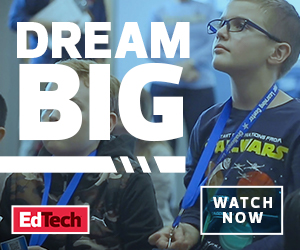The Power of 360-Degree Technology
Thanks to 360-degree videos, teachers can transport their students to new places where they can further engage with the content they’re learning — all without leaving the classroom.
Rather than having students sit back and watch a regular video on a specific topic, these videos allow students to interact with and experience that content.
“360-degree video allows learners to make better connections with their learning by providing concrete, visual explanations and examples,” says Chris Nash, head of community at Discovery Education UK, which offers AR and VR classroom content, in an interview with Blend Media. “By introducing a ‘sense of presence’ to learners, these interactions have the potential to develop greater empathy and deeper understanding.”
The videos, which are captured by 360-degree cameras, offer users a full spherical view of the surroundings — whether it be the halls of an art museum or outer space — from the device of their choice. With just a few simple gestures, users can then choose where to look and explore a scene from different perspectives, giving them the feeling of actually being there.
Many teachers have incorporated 360-degree videos into their lessons because they typically don’t require any special equipment to use. They’re also easy to access inside or outside the classroom.
Google, for example, has the free Expeditions mobile app, which has over 900 virtual field trips that students can explore. Some of the newest ones include working with wildlife in England’s forests and watching the retreat of glaciers.
The app also offers over 100 AR expeditions, which teachers can use to bring abstract concepts to life. For example, students can see 3D visuals of the periodic table or learn how photosynthesis works.
Google also has the Tour Creator, which lets students build their very own 360-degree tours with or without a 180-degree or 360-degree camera. Media companies like CNN, The New York Times and National Geographic also offer a curated list of 360-degree videos that students can explore for free.
Enhance Immersive Experiences with Cardboard Viewers
Powerful VR headsets can deliver a fully immersive experience to students. For instance, the Oculus Quest headset is an all-in-one system with insight tracking, built-in audio and two touch controllers that make movements more precise in a virtual setting.
There are also mobile headsets that can be used with or without smartphones, such as the Veative EduPro VR, which comes with its own content library and mobile device management features, and the ReTrak Utopia 360, which has features that make VR experiences more seamless.
But for schools looking for a low-cost option, cardboard viewers such as the Google Cardboard is a great option. While students can access VR apps and 360-degree videos on a mobile device without a headset, even having a basic viewer can amplify that experience.
With this foldable viewer, users can simply place their phone into the phone slot and view content from their mobile device. The viewer uses focal distance lenses to create an illusion of depth that bring images or videos to life.
Thanks to mobile devices, teachers are able to offer students a more accessible and portable way to experience immersive technology.











